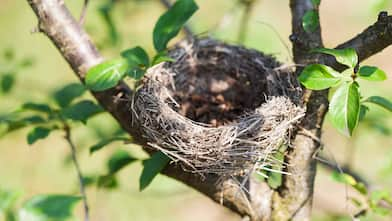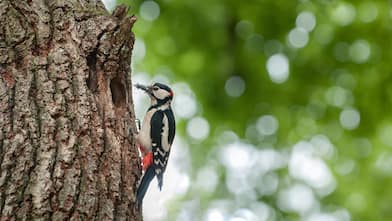Animal Removal Cost Breakdown
Wildlife removal costs run the gamut—and there’s no set pricefor dealing with unwanted houseguests. Before you begin, you’ll want to hire a professional inspector to inspect your property to determine the best course of action Let’s review the factors that will impact your wildlife removal cost.
Type
Depending on the type and size of the critters living in your home, your price will vary. You can expect to pay $85 on the low end and $1,400 on the high end. For example, raccoons and groundhogs are easier to humanely trap and release, whereas skunks are more challenging to remove and release due to their odor, increasing the job cost.
Infestation Damage
Animals that make themselves cozy in your home can cause severe damage to your walls and ceiling. These critters can also destroy insulation, chew through electrical wires, and damage your ductwork, and leave droppings behind. The typical costs to repair damage from a wildlife infestation include:
Drywall repair costs: $300–$900
Insulation replacement costs: $1,000–$2,500
Electrical wiring repair costs: $2–$4 per square foot
Duct repair costs: $12–$25 per linear foot
Siding repair costs: $350–$1,400
Crawl space repair and cleaning costs: $500–$15,000
Length of Time
The longer the animals have been living in your home, the greater the chance that the animal has died. Your dead animal removal cost will run between $150 and $250, depending on accessibility. You can expect to pay additional fees for animals located in hard-to-reach spots, such as removing critters from your attic.
Number of Animals
If you have a large number of animals—say, a family of raccoons living underneath your deck as opposed to one groundhog residing in your garden—you can expect to pay more for animal removal. Most wildlife removal companies charge between $50 and $250 per hour, with humane animal trapping costing between $50 and $350. With a larger number of animals, you can expect more traps, higher labor costs, and several follow-up visits to ensure the proper removal of critters from your home.
Location
Usually, a local animal removal service will charge a flat fee of $150 to $250 for basic trapping and removal. But it becomes more expensive when animals are in hard-to-reach places. These hard-to-reach spaces include:
Attic removal costs: $200–$1,500
Inside walls removal costs: $350 on average
Chimney removal costs: $180–$560
Wildlife Removal by Animal Type
Many varieties of animals would love to make your home or garden their permanent residence. Each of these critters comes with its own removal methods, and it’s always preferable to use humane options, such as live traps and exclusion.
Raccoons
Raccoon removal costs average between $400 and $600. You can expect to pay for services like live trapping, sealing the entrances to your home, and relocating the raccoons. Raccoons must be removed by a professional. In fact, many states protect raccoons by law, and they must be properly removed and relocated.
Squirrels
Squirrel removal costs run between $200 and $600. You can expect wildlife removal pros to live trap and remove squirrels. Squirrels are very active once they get inside homes, and you’ll need to remove them quickly. They’ll destroy walls, insulation, and siding while building their nests, so you’ll need to also factor in the cost of repairing damages.
Skunks
Skunk removal costs average between $300 and $600. Your costs will include live trapping, sealing home entrances, and relocation. Skunks often find their way into crawlspaces and basements while looking for mice, insects, or rats to eat. Since their spray can stick with you and the house, we recommend calling in a pro for this removal and using DIY tactics to get rid of the skunk smell.
Possum
Possum removal costs cost between $250 and $500. You can expect to pay for live trapping and sealing off your home from future possum visitors. Opossums can cause a lot of damage quickly, so it’s vital to identify and remove them swiftly.
Rats and Mice
Rat, mice, and rodent removal costs average between $175 and $550. The most common removal method is live trapping. Wildlife removal pros will only use poison as a last resort, as it can harm humans and household animals. You want to remove rats and mice as quickly as possible—as they can breed and multiply quickly.
Moles
Yard mole removal costs average between $100 and $550. You can expect to pay for live trapping and relocation. Less popular and humane methods include poisonous bait and fumigation. Since moles are generally in your yard and not your house, trapping them tends to be less expensive.
Groundhogs
Groundhog removal costs average between $150 and $200. You can expect to pay for live trapping and relocation. Like moles, they’re easier to catch than animals in your home or crawlspace. You’ll also want to budget for repairs to your foundation, lawn, and house.
Bats
Bat removal costs average between $230 and $700. You can expect to pay for live trapping, releasing the bat back into the wild, and sealing up entry points to your home. Bats are a protected species, and it is illegal to kill them in many parts of the United States. You’ll also want to budget for bat droppings cleanup—which can run between $600 and $8,500, depending on the size of the bat infestation.
Birds
Bird removal costs range from $100 to $300, but removing an active nest can cost up to $2,000. You can expect to have a wildlife pro humanely remove an inactive bird’s nest, sanitize the area, and discard the nest. You can also opt to pay for preventative services—such as installing spikes, which cost between $20 and $35 per 10 feet. Also, if the bird’s nest is in a hard-to-reach area, you can expect your costs to rise.
Cost to Remove Animals Yourself
DIY animal removal is rarely a good idea. You'll save hassle and money by calling a professional removal service at the first sign of trouble rather than trying to remove an animal yourself.
The same goes for sealing off damage left by animal visitors. For example, plugging the holes used by squirrels to get into your attic may seem like a good idea, but chances are it won't work—the squirrels will either cause more damage around the edge of your patch job or become trapped in the attic, forcing them to chew through interior walls. Professional expertise helps seal this correctly.
Trying to seal up skunk entry points poses the same problem, and if you trap the skunk underneath your home or shed, it will die, leading to a terrible smell coupled with bugs and rot. Removing a dead animal is much more expensive than capturing a live one.
Cost to Remove Wildlife Yourself vs. Hiring a Pro
As stated above, removing wildlife without professional help is risky and often unsuccessful. Plus, disease-carrying wild animals pose health risks to your household and domestic pets. However, you can tackle DIY prevention methods, such as purchasing animal repellent sprays or making your own repellant spray out of common household items, such as vinegar, cayenne powder, and Tabasco sauce.
For proper live trapping, relocating, cleaning, and prevention, it’s best to hire an animal removal service near you. You’ll pay anywhere from $150 to $600, but you’ll have peace of mind knowing that critters are no longer tearing up your home and won’t return for more.
How to Remove an Animal Yourself
While we don’t recommend removing wildlife yourself—if you’re going to try, make sure you follow your state’s wildlife management methods. Certain animals require a special license to trap and release. Whereasmost companies aren’t permitted to remove domestic animals.
You'll need to contact your local animal control authority if you have a stray dog or cat on your property. Certain species of wildlife, such as woodpeckers, are also outside the basic authority given to removal companies.So, if you’re going to attempt to remove an animal yourself, here are the steps you should take:
Identification: Properly identify the animal to ensure you choose the correct removal method.
Make a plan: Understand how to humanely catch and remove an animal. Check with your local municipality to find a safe space to release the animal.
Live trapping: You’ll need to purchase a trap and choose the right bait for this method. Once you catch the animal, you’ll also need to release it back into the wild safely.
Repellants: To keep critters away from your home and garden, you can purchase or make your own repellant spray. However, you’ll need to apply these repellants often and they won’t guard your home against large infestations.
Noise devices: Another prevention option is to purchase a noise maker to keep wildlife out of your yard. Yet, animals often get used to the noise, so you’ll need to move the noise device around your property for it to be effective.
How to Reduce Animal Removal Costs
Animal removal costs can add up if you have a large infestation or severe damage from wild animals. While you should always consult a wildlife professional, there are ways to save on animal removal costs, including:
Interview at least three animal removal services to ensure you’re choosing the best service for your infestation.
Act fast and call a wildlife removal specialist at the first sign of an infestation. Swift action will stop animals from reproducing in your home.
Set and reset mouse traps quickly.
Humanely remove an inactive bird’s nest.
Check your home’s foundation for cracks and seal them up.
Seal off your roof, vents, and pipes from curious animals.




